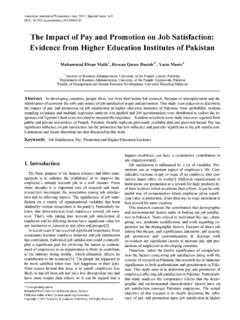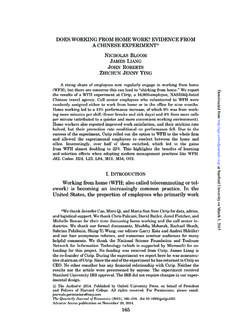Transcription of Interventions to prevent burnout in high risk individuals ...
1 Interventions to prevent burnout in high risk individuals : evidence review About Public Health England Public Health England exists to protect and improve the nation's health and wellbeing, and reduce health inequalities. It does this through world-class science, knowledge and intelligence, advocacy, partnerships and the delivery of specialist public health services. PHE is an operationally autonomous executive agency of the Department of Public Health England Wellington House 133-155 Waterloo Road London SE1 8UG. Tel: 020 7654 8000. Twitter: @PHE_uk Facebook: Core content prepared by Dr Anne-Marie Bagnall, Rebecca Jones, Humaira Akter and Dr James Woodall at The Centre for Health Promotion Research, Leeds Beckett University.
2 For queries relating to this document, contact Crown copyright 2016. You may re-use this information (excluding logos) free of charge in any format or medium, under the terms of the Open Government Licence To view this licence, visit OGL or email Where we have identified any third party copyright information you will need to obtain permission from the copyright holders concerned. Published February 2016. PHE publications gateway number: 2015709. 2. Contents About Public Health England 2. Executive summary 4. 1 Introduction - What is burnout and why is it important? 6. 2 Methodology 9. 3 Discussion: key findings 12. 4 Conclusions 16. 5 References 18. 6 Appendices 22. Appendix A: Flowchart of study selection process 22.
3 Appendix A: Results 23. 3. Executive summary Although there is existing evidence on what works to treat burnout and work- related stress, there is less on what works to prevent it from occurring in the first place. This report provides an overview of the literature on how to prevent burnout and work-related stress in individuals and within organisations. burnout is defined by the International Statistical Classification of Diseases and Related Health Problems as a state of vital exhaustion ( ) under the category of problems related to life-management difficulty ( ). burnout is a prolonged response to long-term emotional and interpersonal stressors on the job. The key dimensions of this response are overwhelming exhaustion, feelings of cynicism and detachment from the job, a sense of ineffectiveness and a lack of accomplishment.
4 burnout is related to workload and time pressure, role conflict and role ambiguity, lack of social support, lack of feedback, lack of autonomy and lack of participation in decision-making. burnout has been associated with absenteeism, intention to leave the job and staff turnover. Among those who remain in the job, burnout leads to lower productivity and effectiveness at work, decreased job satisfaction and a reduced commitment to the job or organisation. burnout is associated with adverse health outcomes associated with stress, such as depression, musculoskeletal pain, type 2 diabetes, cardiovascular disease and premature mortality. Alongside burnout , another commonly used measure is work-related stress.
5 Work-related stress is defined as a harmful reaction to undue pressures and demands placed on employees at work. Understanding how burnout and work-related stress can be prevented and treated in workplaces is of great importance both from a public health perspective and for businesses aiming to reduce absenteeism and increase productivity. Summary of methodology This evidence review is one of four commissioned by Public Health England exploring certain priority but generally under-explored issues around health, work and unemployment. The target audience is a combination of local government, national organisations interested in health and work, and businesses themselves. The content of this report was developed by The 4.
6 Centre for Health Promotion Research using a search of relevant published and grey literature. Limitations Much of the literature on burnout is within health care organisations and large-scale organisations. There is a gap in the evidence of Interventions that work in small or medium size organisations and across other sectors. Workplaces are diverse; therefore simply replicating Interventions effective in one workplace to another may not be effective or appropriate. While areas for action and future research are identified in this evidence review, transferring Interventions between contexts should be done with caution. There is no valid differential diagnostic instrument of burnout and it is used interchangeably in this evidence review with work-related stress due to the overlaps between the two.
7 Therefore, the conclusions of this evidence review refer to both burnout (as defined within this evidence review) and work- related stress. Key findings Interventions designed to reduce symptoms and impact on burnout and work- related stress were conducted more often at an individual or small-group level than at an organisational level. Individual level Interventions that can reduce burnout include staff training, workshops and cognitive-behavioural programmes. Changing aspects of the organisation's culture and working practices might be considered alongside individual level Interventions to more effectively prevent burnout . Changes to workload or working practices appear to reduce stressors and factors that can lead to burnout .
8 There is some evidence to suggest that organisational Interventions produce longer-lasting effects than individual approaches. This evidence review supports the wider literature which argues that organisational Interventions in the workplace may be more effective than individual Interventions alone. This might involve combining proactive preventative approaches focused at the organisational environment and secondary management approaches directed at individuals . Combining individual and organisational level approaches includes a system change that adopts a participatory environment, promotes open communication, manager and peer support, a culture of learning and successful participation of employees in planning and implementation of programmes.
9 5. 1 Introduction Rationale for this evidence review Workplace health and worklessness are a corporate priority for Public Health England (PHE), as employment is a wider determinant of health. PHE is interested in how work-associated Interventions can support the local delivery of outcomes across the public health outcomes framework burnout prevention has been raised as an issue through PHE's engagement with businesses in both the private and public sector. Specifically, what Interventions work with individuals who are considered at high risk of burnout . There is some evidence of Interventions for individuals who already have clinically established burnout . However, less is understood about Interventions line managers could use in the pre- burnout phase.
10 The Centre for Health Promotion Research (CHPR) was therefore commissioned to undertake a rapid evidence review of Interventions to prevent burnout . What is burnout ? burnout is defined by the International Statistical Classification of Diseases and Related Health Problems as a state of vital exhaustion ( ) under the category of problems related to life-management difficulty ( ).1. burnout is a prolonged response to long-term emotional and interpersonal stressors on the The key dimensions of this response are overwhelming exhaustion, feelings of cynicism and detachment from the job, a sense of ineffectiveness and a lack of However, a recent systematic review of differential diagnosis of the burnout syndrome4-5 concluded that currently there is no valid differential diagnostic instrument for burnout .


















